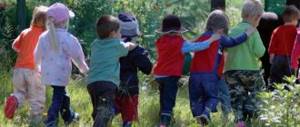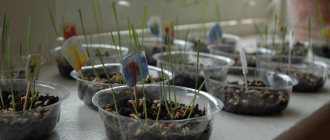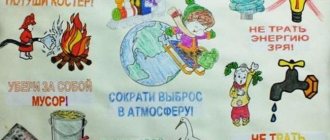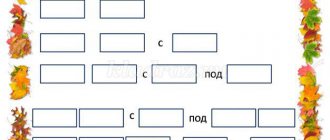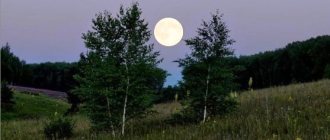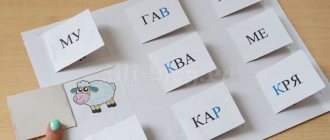Nature and the man-made world: educational games for children, cards for downloading. educational video for children about living and inanimate nature.
From this article you will learn how to introduce your baby to the world around him, how to explain what living and inanimate nature is, what the man-made world is and how they differ, what educational and educational games will help you.
Today I am pleased to introduce another reader of the “Native Path” website and a participant in the “Growing with the Native Path” competition. This is not only a mother of many children, but also a student at a pedagogical college and a kindergarten teacher by profession. Marina has prepared a game for readers of “Native Path” to familiarize children with the world around them.
I give the floor to Marina: “My name is Smirnova Marina Anatolyevna. I’ve been on the “Native Path” website for a short time—about a year. I live in the village. Chastoozerye. I have three children, a 4th year student at a pedagogical college. I work as a kindergarten teacher. I’m interested in beadwork, drawing (both with pencils and paints), plasticineography, modular origami, sewing simple felt toys for activities, making various crafts, etc. I recently started making educational games for children.” And today Marina Anatolyevna shares with us two games and cards for them.
In didactic games, children not only clarify their ideas about the world around them and the need to take care of it, but also develop: coherent speech, cognitive interest, the ability to analyze, compare, generalize, group objects, and children’s attention.
In didactic games, children learn that the objects around them are different.
Some objects are made by man (the man-made world), while other objects are created by nature (the natural world).
The natural world is also very diverse. There is living nature, and there is inanimate nature.
The natural world includes the stars and the Moon, forests and mountains, grass and trees, birds and insects. These are those objects that exist outside of man; he did not make them with his own hands or with the help of machines and tools.
- Inanimate nature includes snow and sand, a ray of sun and stones, clay and mountains, rivers and seas.
- Living nature includes plants, fungi, animals and microorganisms.
The man-made world includes our clothes and shoes, houses and vehicles, tools and hats and much more, shops and other buildings around us, stadiums and roads.
How to explain to children how the natural world differs from the man-made world and how living and inanimate nature differ from each other?
It is very well explained to children what nature is and how living and inanimate nature differ in my favorite program for children about the world around us, “Shishkina School. Natural History". Watch this educational and fun program for kids with your children. Play the game with its characters, discuss their answers and mistakes.
What kingdoms does the natural world consist of?
Children will learn about this from the program
“Shishkina School” on the topic “Kingdoms of Nature”, and together with the animal heroes of the program, they will guess riddles about the inhabitants of these kingdoms
And now that your baby has learned what nature is, how to distinguish the natural world from the man-made world, how to distinguish living and inanimate nature, let's play a didactic game and consolidate and clarify children's ideas about the world around them. And Marina’s games and cards will help us with this.
Didactic game 1. “Living and inanimate nature”
Material for the game
- Pictures depicting objects of living and inanimate nature (planet earth, duckling, forest, butterfly, mushroom, mountains, etc.)
- Red and green cards (for each child)
- Two dolls or other toys.
Progress of the game
Create a play situation with toys. Two toys (dolls) quarreled and cannot separate the pictures. Ask the children: “How can we reconcile our dolls? How can you share these pictures between Katya and Masha?” Children discuss how they can help their toys.
Draw the children's attention to the cards - hints, remember what they mean. The duckling is the world of living nature. And mountains are a world of inanimate nature. The child helps the dolls divide the pictures correctly.
- You can give pictures to dolls, for example, give cards to Masha doll with images of living nature, and give cards to Katya doll with images of inanimate nature.
- Or you can enter conditional icons. The duckling card is green and the mountain card is red. Invite the children to cover the pictures depicting living nature with green squares (like the duckling), and cover the pictures depicting inanimate nature with red cards (like the “mountains” card).
- If the game is played with a group of children, then the adult gives each child a set of pictures and red and green cards for laying them out.
The children’s task is to correctly divide all the pictures into two groups.
Doll Masha and Katya each take their pictures and thank the children for their help, praising them for being very quick-witted and inquisitive.
Download pictures for the game “Living and Nonliving”
Progress of the game:
The teacher shows a picture of an animal. Children must determine where it lives and put the picture on the desired image.
Didactic game
“Whose shadow is this?”
Target:
- develop the ability to find given silhouettes by superimposing;
- teach to distinguish animals by their body structure features;
- develop cognitive activity;
- cultivate a caring attitude towards animals;
Equipment: a box with dark silhouettes of animals, colored cards with images of animals.
Didactic game 2. Nature and the man-made world
In this game, children will learn to distinguish objects of the natural world from objects made by human hands, classify pictures, reason and draw conclusions, and describe objects.
Materials for the game
For the game you will need pictures depicting objects of the natural and man-made world (anthill, mirror, bell flower; electric lamp, etc.).
Progress of the game
A group of children is playing. You can also play in pairs “adult and child”.
Each child receives from an adult a set of pictures depicting various objects of the man-made world. An adult shows a picture of a natural object.
For example, an anthill is the home of ants. Children look among their pictures for objects of the man-made world that look like an anthill. For example, a pair for an anthill can be a modern house, a birdhouse, a stable, or a poultry house, made by human hands. Or perhaps your child will find another pair and be able to prove that it is suitable, because... similar to the original picture in some way.
You need to not only guess and find the right picture, but also prove that this picture matches the picture shown to adults.
Examples of such pairs in cards for the game:
- bell flower (natural world) - bell (man-made world),
- the sun is a light bulb,
- hedgehog - metal brush - comb with long teeth,
- live butterfly - a butterfly for a festive costume,
- planet Earth - toy ball,
- cobweb - fishing nets,
- swallow with wings - airplane with wings,
- cancer claws - pincers as a human tool,
- snowflake and snowflake - lace napkin,
- A living mouse is a computer mouse.
Progress of the game:
Invite the child to place the leaves on the trees of the corresponding color so that the leaves are the same color as the tree.
Didactic game
“Whether in the garden or in the city...”
Target:
— expand children’s of the diversity of the plant world, in particular vegetables and fruits;
- learn to recognize them and name them correctly;
— consolidate children’s knowledge about what grows in the garden or vegetable garden;
- develop logical thinking, memory and speech of children ;
- cultivate a friendly relationship during the game;
Equipment:
pictures depicting a garden and vegetable garden, cards depicting various fruits and vegetables.
Didactic games to familiarize yourself with the outside world for children from 2 to 3 years old.
Exploring the natural world
Find the same leaf
Introduce your child to the concept of “leaf fall.”
Collect fallen leaves. Together with your baby, inhale this unique smell of autumn foliage, hold the leaves up to the light, and admire their color and vein pattern. Place birch and maple leaves in front of your baby and draw his attention to their differences in color, size and shape. Then, show your child, for example, a maple leaf and ask him to find the same one. Then try to find the tree from which that leaf fell.
Sort the leaves
Take an armful of leaves and place them on a bench. Then invite the baby to arrange all the leaves into two piles according to some specific characteristic: large and small leaves; yellow and red; birch and maple.
What does it look like?
When collecting natural material, determine what is similar to what. For example, a cone - for a hedgehog, an acorn cap - for a real cap, ash and maple wings - for flower petals, etc. When you return home, you can make appropriate crafts.
Autumn wreath
Show your child how to weave a wreath from autumn leaves. Take a photo of your child wearing this fall wreath.
Birds and animals
Prepare figurines of various animals or cards with their images. Look at the animals with your child and highlight their common characteristics (they have a head, ears, nose, body, paws, tail, their bodies are covered with fur). In the same way, look at and comment on the images of birds (they have a head, a beak, no ears or nose, their bodies are covered with feathers). Then invite your child to distribute all the cards into two groups: birds and animals.
Domestic and wild animals
Draw a house and a forest. Prepare cards with images of domestic animals and inhabitants of our forests. Invite your child to classify the animals into those that live near people and those that can only be found in the forest.
Who's flying?
You show your child object pictures depicting various animals. If this animal flies (crow, dragonfly, etc.) - the child waves his arms as if he is flying. If the animal cannot fly, the child does nothing or claps his hands. You can also depict who can swim (crocodile, duck, fish) or who can jump (grasshopper, frog, cat).
Third wheel
You can offer your child the game “third wheel”. Place three cards in front of him: two mushrooms and one apple. Ask what is unnecessary here. At first, the “extra” item should be significantly different from the other two (two potatoes and a penguin, two oranges and a pine cone), a little later the difference should be less pronounced (two apples and a pear, two porcini mushrooms and a russula).
What's in the basket?
Place vegetables and fruits in the basket (1-2 pieces of each type). Let the child take them out of the basket one at a time and name them. You can also put it in two bowls - vegetables and fruits. Or draw a tree and a bed on cardboard and lay the fruits on them. Or an even more interesting task is to “cook” compote and soup: put fruits in a jar and vegetables in a pan. Exploring the world of objects
What's in the box?
The box contains various items (a button, a comb, a felt-tip pen, a book, etc.). The child takes them out in turn, names them and says why they are needed.
Transport
Take one car out of the box at a time: car, truck, bus. Examine and note the material from which each machine is made, its color, purpose, etc. Highlight their common features (all cars have wheels, a steering wheel, a cabin) and their differences.
Dishes
Draw a cabinet with shelves on a piece of paper with a pencil. Say that now you need to fill the cupboard with dishes. Let the child tell you what to draw, and you will “arrange”: a cup, a pan, a teapot, etc.
Select items
Various items are laid out on the table. Invite your child to choose only those items that will help him wash himself in the morning (soap, towel, toothbrush, toothpaste) or items that are necessary for food (plate, spoon, fork).
Clothes and shoes
Select subject pictures with images of clothing, or you can use illustrations from books. Based on the pictures, discuss with your child what clothes and shoes should be worn when it is cold or, conversely, hot outside.
Dressing up the doll
Take the doll. Invite your child to go for a walk with her, but first he will have to choose clothes for her according to the weather (if it’s winter now, then you need to dress her in a warm fur coat, hat, boots).
Looking at story pictures
In order to study the surrounding environment, plot pictures are very suitable, where, for example, the furnishings of a room are depicted - then you can discuss with your child what a table, a chair is needed for, what is put away on shelves and what is stored in a closet, etc. Introduction to work
Wash
Pour water into a basin for your child, fill it with foam and offer to wash handkerchiefs or doll clothes. And then rinse the laundry in a bowl of clean water. And of course, a special pleasure for the child is to hang it all up to dry on a line, securing it with clothespins.
Washing dishes
Sometimes doll dishes also need to be washed. Prepare two basins: one with soapy water, the second with clean water. Show your child how to first wash dishes in the first basin with a sponge, and then rinse them in the second and dry them with a towel.
Conversations based on pictures
With your child, look at story pictures that depict people’s work: “A bus driver is carrying children,” “A doctor is treating a boy,” “A gardener is planting trees,” etc. Discuss what is drawn: who is shown in the picture, what each of them is doing, what would happen if there were no doctors, teachers, educators, etc.
Didactic games to familiarize children 2-3 years old
with the outside world
Progress of the game:
On the table in front of the children are cut-out pictures depicting a familiar object (apple, pear, orange)
.
Children are invited to carefully examine and assemble a picture from separate parts , by applying one half to the other to form a whole object. At the end of the game, the teacher encourages the children to name the item they received (fruit, etc.)
.
Didactic game
"Find the cub's "
Target:
— teach wild and domestic animals from pictures
- cultivate a love for nature;
- develop hand motor skills;
Equipment:
Pictures with images of animals: cats, dogs, kids, cows, pigs.
Progress of the game. The teacher shows the children pictures of animals: cats, dogs, kids, cows, pigs. The child names the animals by guessing what sounds they make. Then the adult invites the children to match the pictures of “adult animals”
pictures depicting their babies .
Didactic game
"Whose house"
Target:
— introduce the places where some animals live, develop attention, memory, and logical thinking.
Equipment:
Cover matchboxes with colored paper. Paste drawings of animals on the outside of the boxes and animal houses inside.
Progress of the game:
The teacher shows a picture of a fruit or vegetable. Children must determine where it grows and place the picture on the correct image.
Didactic game
"Fruits. Vegetables"
Target:
- introduce children to the simplest classification;
- continue to develop the ability to independently recognize them and name them correctly;
— to form basic environmental knowledge;
Equipment: two dolls, two baskets, a set of cards depicting vegetables and fruits.
